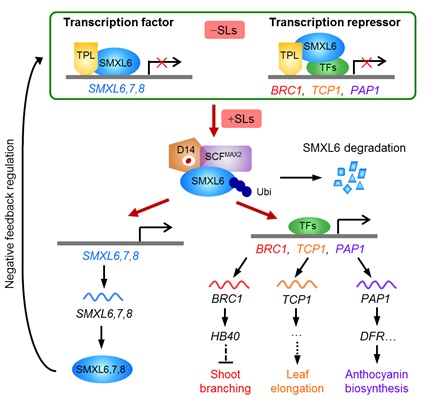Strigolactones (SLs) are carotenoid-derived plant hormones that have fundamental effects on shoot branching, leaf development, plant height, anthocyanin accumulation, root architecture, and adaptation to drought and phosphate starvation. SLs also function as rhizosphere signals important for interactions between host plants and symbiotic arbuscular mycorrhizal (AM) fungi or root-parasitic plants.
The research group led by Prof. LI Jiayang from the Institute of Genetics and Developmental Biology (IGDB), Chinese Academy of Sciences, has identified key components in SL biosynthesis and signaling, and proposed the SL signaling model featured by the SL-triggered ubiquitination and degradation of D53.
The limited knowledge of SL responsive genes has seriously hampered the understanding of SL signaling. Recently, Prof. LI and collaborators synthesized SL analogs GR244DO, GR245DS and rac-GR24, and compared their effects in stimulating SL signaling. GR244DO specifically stimulates SL signaling in a D14-dependent manner, and efficiency of GR244DO is higher than that of GR245DS and rac-GR24.
Through RNA-SEQ analysis, they identified 401 SL responsive genes after GR244DO treatment for 2 h and 4 h. Genetic analyses further indicated that SLs repress shoot branching through transcriptional activation of BRC1, which further promotes expression of HB40 and ABA accumulation in axillary buds. However, BRC1 is not required for SL-regulated leaf elongation. Instead, TCP1 is important for leaf elongation promoted by SL signaling. Furthermore, SLs promote anthocyanin accumulation through transcriptional activation of PAP1 and its homologues PAP2, MYB113 and MYB114. These findings demonstrate that SLs control diverse aspects of plant development through distinct SL responsive genes.
They further identified 729 SMXL6-target genes through ChIP-SEQ analysis and found that SMXL6 failed to directly bind the BRC1 promoter in EMSA assays, indicating that SMXL6 may work with unknown TFs to inhibit downstream gene expression. Notably, they found that SMXL6, SMXL7 and SMXL8 directly bind each other’s promoters in vitro. The ATAACAA motif in SMXL7 promoter is required for the direct binding and transcriptional repression of SMXL6 on the SMXL7 promoter.
These findings demonstrate that SMXL6, 7, 8 could directly bind DNA and function as self-regulating transcription factors, revealing a novel mechanism distinguished from the classical model that repressor proteins in IAA, JA, GA, and SL signaling need transcription factors to repress gene expression.
“A landmark study by Wang et al. renders a panorama of transcriptional regulation in SL signaling. The finding that SUPPRESSOR OF MAX2 LIKE 6 (SMXL6) also functions as an auto-regulated transcription factor (TF) causes a paradigm shift in current view of transcriptional repressors in phytohormone signaling.” said Prof. CHU Chengcai from IGDB.
The paper entitled “Transcriptional regulation of strigolactone signalling in Arabidopsis” was published online in Nature on June 11, 2020 (doi.org/10.1038/s41586-020-2382-x.).
This research was supported by National Natural Science Foundation of China and Chinese Academy of Sciences.
Model of transcriptional regulation by SMXL6 in SL signaling (Image by IGDB)
In SL signaling, SMXL6 directly binds promoters of SMXL6,7,8 and functions as an auto-regulated transcription factor (TF). Meanwhile, SMXL6 can also form a complex with unknown TFs that are expected to recognize and bind to the promoters of BRC1, TCP1 and PAP1, thus regulating shoot branching, leaf elongation and anthocyanin biosynthesis in Arabidopsis thaliana.
Contact:
QI Lei
Institute of Genetics and Developmental Biology, Chinese Academy of Sciences
 Model of transcriptional regulation by SMXL6 in SL signaling (Image by IGDB)In SL signaling, SMXL6 directly binds promoters of SMXL6,7,8 and functions as an auto-regulated transcription factor (TF). Meanwhile, SMXL6 can also form a complex with unknown TFs that are expected to recognize and bind to the promoters of BRC1, TCP1 and PAP1, thus regulating shoot branching, leaf elongation and anthocyanin biosynthesis in Arabidopsis thaliana.Contact:QI LeiInstitute of Genetics and Developmental Biology, Chinese Academy of SciencesEmail: lqi@genetics.ac.cn
Model of transcriptional regulation by SMXL6 in SL signaling (Image by IGDB)In SL signaling, SMXL6 directly binds promoters of SMXL6,7,8 and functions as an auto-regulated transcription factor (TF). Meanwhile, SMXL6 can also form a complex with unknown TFs that are expected to recognize and bind to the promoters of BRC1, TCP1 and PAP1, thus regulating shoot branching, leaf elongation and anthocyanin biosynthesis in Arabidopsis thaliana.Contact:QI LeiInstitute of Genetics and Developmental Biology, Chinese Academy of SciencesEmail: lqi@genetics.ac.cn CAS
CAS
 中文
中文




.png)
